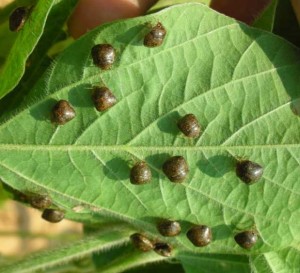Get Ready For Spring . . . And Pests

Adult kudzu bugs on a soybean leaf.
At long last, the calendar is officially turning from winter to spring. And I’m sure I can speak for those throughout much of the country when I say it’s about time!
By any definition, the winter of 2013-14 has been brutal. Arctic blasts, major snowstorms and disrupted travel are just a few of the lingering aftereffects of this snow season.
Of course, for growers, this winter could have some benefit come spring and summer. According to most industry insiders, the frigid temperatures should have killed off many overwintering insects.
Still, in the nation’s corn and soybean fields, there will be a relatively new pair of insects that will bear watching during 2014. Both the brown marmorated stink bug and kudzu bug have started expanding their distribution in the U.S. and ag retailers should expect many growers to request help controlling these pests. Although both insects have various host plants they feed upon, they have apparently both developed a taste for soybeans in the U.S. (the pods for the stink bug and stems for the kudzu bug).
Besides feeding on different parts of the same plants, both brown marmorated stink bugs and kudzu bugs are extremely hard to control. In fact, according to Dr. Galen Dively, entomology professor emeritus for the University of Maryland, both pests have shown an ability to “recover from applications of pyrethroid-based insecticides.”
At present, both kudzu bugs and brown marmorated stink bugs are limited to crop fields in the Mid Atlantic, Southeast and Mid-south regions of the country. But according to Dr. Jeremy Greene, professor/researcher and Extension entomologist at Clemson University, both insects are increasing the territories each year.
“So the message is clear – if you don’t yet have these insects as a problem in your crop fields, it probably won’t be long before you do,” says Greene.






